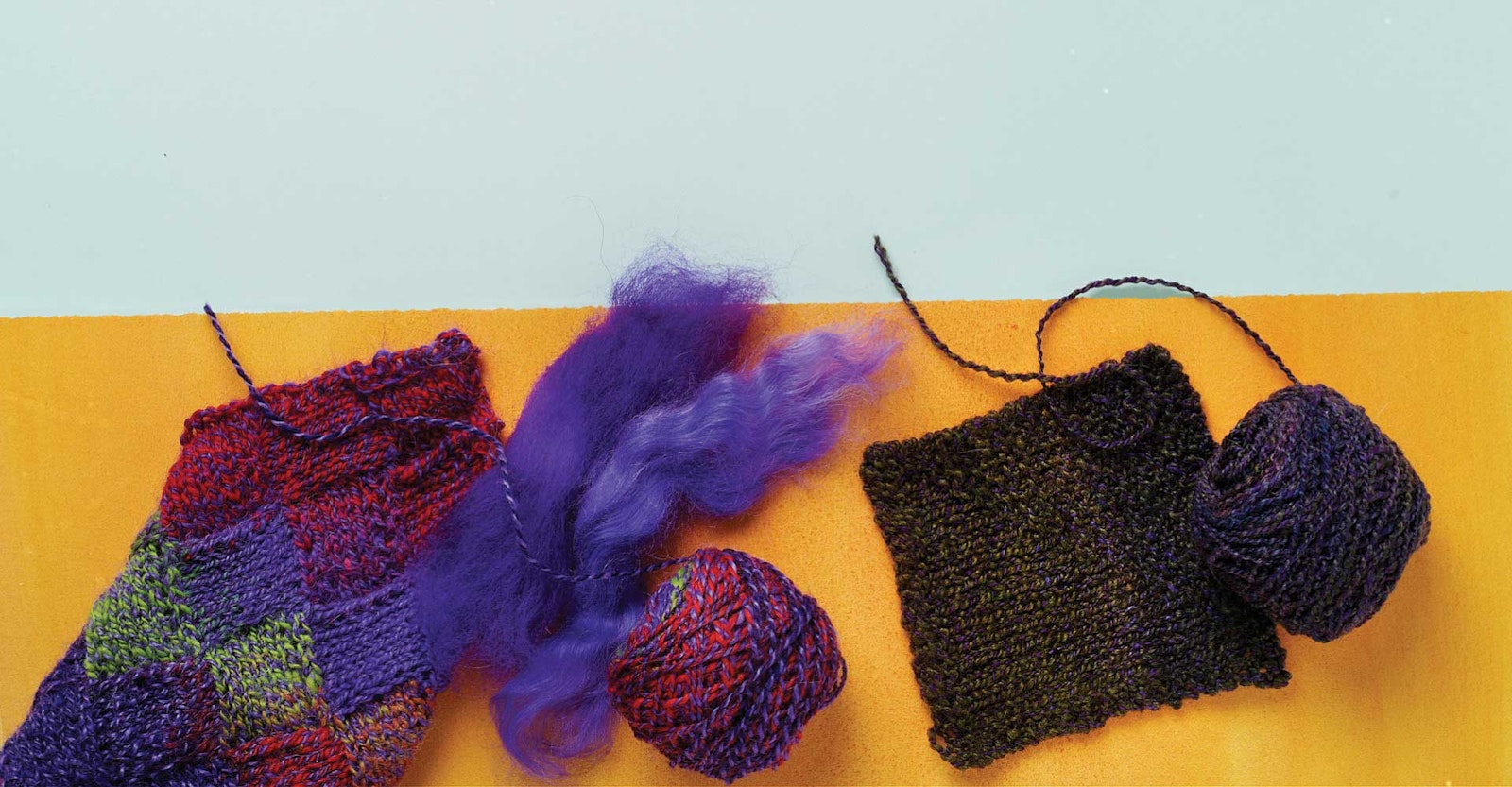In part one of Two Threads Are Better Than One, we discussed different reasons for combining singles into unique two-fiber plied yarn. Here, we talk about a variety of fiber combinations and give you a few ideas for what to do with those small bits of yarn you may have lying around.
Ideas and Suggestions
The possibilities are not quite infinite, but the potential for fiber combinations—not to mention colors or design options—are sufficient to provide years of entertainment and to reduce the stash before it takes over another box (or closet).
Angora/wool: This is a classic blended combination that brings together the best of both fibers: warmth of angora lightened by strength of wool. Angora will halo, providing an extra layer of insulation. Any combination with angora should be knitted at a larger gauge than usual to give the angora yarn room to open up; similarly, any woven item should have a more open sett. The gray cap on page 63 uses about 1.8 ounces of yarn (gray Finn sheep with angora top).
Angora/silk: Angora by itself is not a very strong yarn and tends to slip apart if not spun firmly. Overspinning defeats the benefit of allowing the ends to slip free to form the halo, but angora does need firmer than normal twist in the singles to hold together when plied. Silk should also be spun with high twist and is a strong fiber, making it an excellent candidate to combine with angora. The sample yarn on page 64 would make an excellent knitted simple shawl; exuberant lace patterning would be lost when the angora begins to fuzz out.
Wool/silk— The red wool on page 64 is actually a wool/tussah silk (70/30) blend combined with a fine red silk. After extolling the benefits of combining plies rather than blending fibers, why use a blend? I had the gorgeous fiber from a previous project, but it wasn’t sufficient to make enough yarn to do anything with. Then I found the fine red silk, which had been lurking in the bottom of a drawer.
Alpaca/silk— The alpaca single on page 65 is from a not-so-high-quality roving with lots of vegetable matter. It is, however, a lovely soft tan in color, and the silk blend is a beautiful light golden tussah. This combination was designed to create a yarn less dense than alpaca alone, with sparkle added by the silk. Both singles are fairly fine.
Alpaca/wool— The alpaca single is the same as the one used for the alpaca/silk combination above. The wool on page 65 was labeled “Wensleydale,” and it is a very coarse-feeling wool, though the gold-to-orange colorway is lovely. I thought this would be an excellent choice to test my theory that a ply of alpaca would improve the texture and hand of any wool. The resulting yarn is not exactly close-to-the skin soft but certainly an improvement on the Wensleydale alone.
Wool/mohair— The multicolored wool in the sample at left had a label identifying it as “BFL.” I love the bright colors and hesitated to do more than admire the cheerful combination, because plying two singles would potentially lose the strong colors. There was only 1.7 ounces, hardly enough for even a small project. Then I found the purple-dyed mohair in the bottom of a bin. I spun thin mohair singles and moderately thin wool singles, then plied. The solid color unifies the disparate colors and adds a lustrous sparkle.
Ideas for Small Amounts of Yarn
You don't need much yarn to make any of the following projects!
- A headband takes 1½ to 2 ounces of yarn, more for heavier yarn, less for lighter. A different yarn can be used for the inside and outside, making this a great way to use even small amounts of yarn. A gauge swatch will be necessary to determine the number of stitches to yield 19 to 20 inches in diameter.
- Stripes do not have to occur evenly spaced or regularly repeated across the entirety of a garment or project. A small amount of yarn can be used for a contrasting color border at the beginning of mittens or a hat or as part of intarsia colorwork or I-cord. For a woven project, stripes in a warp or weft add a color highlight. Stripes do not even have to be the same size yarn.
- Make a scarf or shawl, depending on how much yarn is available, by knitting each row in a different yarn and leaving 3 or 4 inches at the beginning and end of each row for fringe. You will need a gauge swatch to figure out how many stitches to cast on for a length of 72 inches, or your preference.
- Hats take remarkably small amounts of yarn—even less than 2 ounces for a simple close-fitting cap.
- Entrelac is a great way to use small amounts of yarn because each row or even each square can be knitted in a different color.
What Now?
By now you may be inspired to dig into the stash bin (or closet) and spin singles to be plied with singles of other fibers. The resulting yarns may still only be an ounce or two, or a hundred or so yards, which is probably not enough for more than a very small project. But don’t let this be an excuse for inaction; small bits of yarn can be used for a variety of projects.
Two strands plied together is a minimum, not a maximum. Match colors and play with combinations. Working with small amounts of fiber is liberating because there isn’t that much to lose if it doesn’t work out quite as expected. And sometimes, even then, the unexpected can be more exciting than the intended.
Resources
Walker, Barbara G. A Treasury of Knitting Patterns. Pittsville, Wisconsin: Schoolhouse, 1998 (reissue).
———. A Second Treasury of Knitting Patterns. Pittsville, Wisconsin: Schoolhouse, 1998 (reissue).

